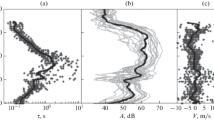Abstract
A mechanism behind the longitudinal stability of technogenic ionized formations in air is considered. Air is ionized by radioactive emergency ejections from dangerous plants. The stability mechanism is based on cloud polarization when unlike heavy ions are separated under the action of the force of gravity. The longitudinal and transverse distributions of the heavy ions (charged water drops), as well as the distribution of their difference, calculated in a cylindrical coordinate system agree well with experimental data found in the literature. The reflection coefficient for electromagnetic waves reflected from an ionized air layer is derived. The wavelength dependence of the absolute value of the reflection coefficient is consistent with experimental and analytic data for the centimeter range of wavelengths. A range where the magnitude of the reflection coefficient sharply grows is found.
Similar content being viewed by others
References
A. P. Elokhin and E. N. Kononov, At. Énerg. 80, 129 (1996).
A. N. Didenko, Yu. P. Usov, Yu. G. Yushkov, et al., At. Énerg. 80, 47 (1996).
V. L. Ginzburg, The Propagation of Electromagnetic Waves in Plasmas (Nauka, Moscow, 1967; Pergamon, Oxford, 1970).
V. V. Smirnov, in Proceedings of the Institute of Experimental Meteorology, Vol. 19: Ecological-Geophysical Aspects of Nuclear Power Station Monitoring (Gidrometeoizdat, Moscow, 1992), pp. 45–60.
K. Kato, in Collection of Reports of Society of Earthquake Forecast (1984), No. 33, pp. 184–186.
Ya. I. Frenkel’, Theory of Phenomena of Atmospheric Electricity (GITTL, Moscow, 1949).
G. A. Vorob’ev, Physics of Dielectrics, Strong Fields Region (Tomsk. Univ., Tomsk, 1977).
V. V. Smirnov in Proceedings of the Institute of Experimental Meteorology, Vol. 19: Ecological-Geophysical Aspects of Nuclear Power Stations Monitoring (Gidrometeoizdat, Moscow, 1992), pp. 111–122.
Calculation of Radioactive Material Propagation in the Environment and Radiation Dose for Population (MKhO Interatoménergo, Moscow, 1992), p. 59; p. 248.
H. Kuchling, Physik (Fachbuchverlag, Leipzig, 1980; Mir, Moscow, 1982).
A. A. Samarskii, The Theory of Difference Schemes (Nauka, Moscow, 1977).
É. Ya. Begun, E. S. Dmitriev, A. B. Ivanov, and G. P. Markov, in Radiation: Latent Ecological Problems (ANRI, 1998), No. 1, pp. 15–19.
R. Holzer, in Nuclear Explosion in Space, on the Earth, and under Water (Voenizdat, Moscow, 1974), pp. 219–234.
L. M. Brekhovskikh, Waves in Layered Media (Nauka, Moscow, 1973; Academic, New York, 1980).
L. M. Brekhovskikh, Zh. Tekh. Fiz. 19, 1126 (1949).
P. H. van Cittert, Physica 6, 840 (1939).
K. A. Boyarchuk, E. N. Kononov, and G. A. Lyakhov, Pis’ma Zh. Tekh. Fiz. 19(6), 67 (1993) [Tech. Phys. Lett. 19, 184 (1993)].
N. G. Gusev, E. E. Kovalev, D. P. Osanov, and V. I. Popov, Radiation Protection against from Distant Source (Gosatomizdat, Moscow, 1961), Part II.
A. P. Elokhin, RF Inventor’s Certificate No. 2147137 (2000).
Additional information
__________
Translated from Zhurnal Tekhnichesko\(\overset{\lower0.5em\hbox{$\smash{\scriptscriptstyle\smile}$}}{l} \) Fiziki, Vol. 71, No. 8, 2001, pp. 98–108.
Original Russian Text Copyright © 2001 by Elokhin.
Rights and permissions
About this article
Cite this article
Elokhin, A.P. On the longitudinal stability of technogenic ionized formations. Tech. Phys. 46, 1026–1036 (2001). https://doi.org/10.1134/1.1395125
Received:
Accepted:
Issue Date:
DOI: https://doi.org/10.1134/1.1395125




